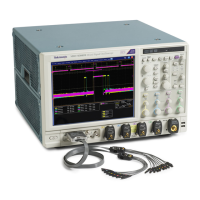Commands Listed in Alphabetical Order
Group
Measurement
Syntax
MEASUrement:MEAS<x>:DELay: DIREction {BACKWards|FORW ards}
MEASUrement:MEAS<x>:DELay: DIREction?
Related Commands
MEASUrement:MEAS<x>:SOUrce<x>
Arguments
BACKWards means that the search starts at the end of the wa ve form
and l
ooks for the last rising or falling e dge in the waveform. Use the
MEASUrement:MEAS<x>:DELay:EDGE<x> command to specify the slope
of the edge.
FORWards means that the search starts at the beginning of the waveform
and looks for the first rising or falling edge in the waveform. Use the
MEASUrement:MEAS<x>:DELay:EDGE<x> command to specify the slope
of the edge.
Examples
MEASUREMENT:MEAS1:DELAY:DI RECTION BACKWARDS starts searching from
the end of the waveform record.
MEASUREMENT:MEAS3:DELAY:DI RECTION? might return
:MEASUREMENT:MEAS3:DELAY:D IRECTION BACKWARDS, indicating
that the current search direction is backwards.
MEASUrement:MEAS<x>:DELay:EDGE<x>
This command sets or queries the slope of the edge that is used for the delay
“from” waveform (edge1) and the d elay “to” waveform (edge2) when taking a
delay measurement. Use the MEASUrement:MEAS<x>:SOURCE2 command
to specify the waveform. This command is equivalent to selecting Time from
the Measure menu, choosing Delay from the drop-down list and then clicking
the desired Delay Edge setting. Measurements are specified by x, which ranges
from 1 through 8.
Group
Measurement
Syntax
MEASUrement:MEAS<x>:DELay: EDGE<x> {FALL|RISe}
MEASUrement:MEAS<x>:DELay: EDGE<x>?
Related Commands
MEASUrement:MEAS<x>:SOUrce<x>
DPO7000, DPO70000/B and DSA7000/B Series Programmer Manual 2-385

